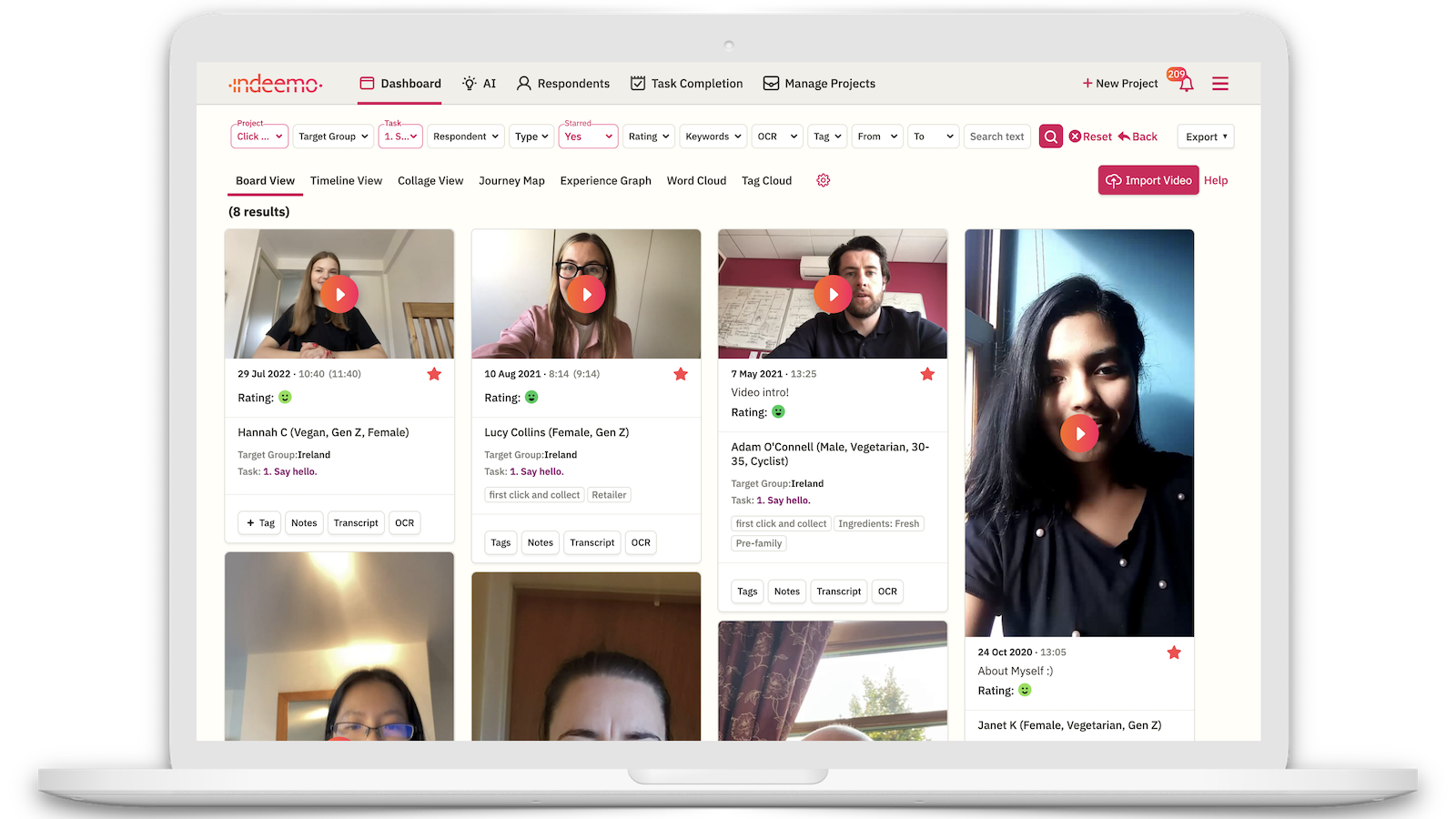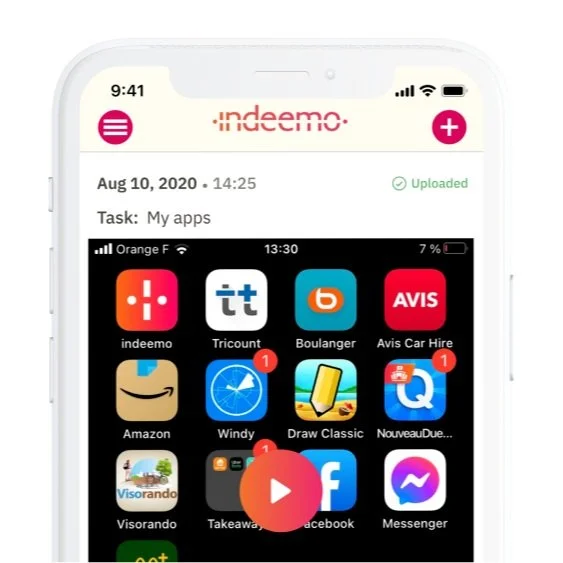The Definitive Guide to Digital Ethnography
What is Digital Ethnography?
Digital Ethnography also known as Mobile Ethnography (what is Mobile Ethnography) is a modern, digital first way to conduct remote ethnographic research.
Digital Ethnography has its origins in traditional Ethnography, but leverages Smartphones, Video and Generative AI powered Dashboards to help Researchers remotely capture rich, contextual insights into human needs, emotions, behaviours, journeys and experiences.
How does Digital Ethnography work?
Planning a Digital Ethnography project works in a relatively similar way to how you would plan a traditional ethnography project.
The principles and workflows are broadly the same but you avoid the need to travel to conduct the ethnographic research.
Respondent recruitment is similar to recruiting for a Focus Group or Interview. You can use your own respondents, work with a dedicated qualitative research recruiter or use platforms that offer recruitment as part of their offering. (Check out our Recruitment guide)
You also incentivise research participants the same way (and with a similar amount) as you would for in-depth interviews (IDI’s) or focus groups.
The main difference is that you design a set of tasks for respondents to complete asynchronously where they show you what they do themselves rather than have them tell you what they think they do.
They use their smartphones to record videos, take photos, write texts or do screen recordings to show you and tell you what they are doing, feeling and thinking in the context of their everyday lives.
Who is Digital Ethnography for?
We are getting close to a time where nearly every consumer on the planet will own a smartphone. This means that it is possible to connect with any person, any where at any time.
This ability to connect privately with any one in the context of their every day lives is driving the growth of digital ethnography.
As a result, it is now the default approach for the progressive Market Research, Experience Design and Healthcare Research clients that we support.
Viewing the research landscape through the lens of the industry sector, it is popular with everyone from leading consumer brands, to academic researchers to technology startups to healthcare providers and government departments.
Hybrid work has accelerated the growth of Digital Ethnography as it gives researchers the ability to conduct research remotely without the need to travel.
The benefits set (outlined below) are compelling.
The breadth of personas utilizing this ethnographic research approach is also significant ranging from; UX Designers and Product Managers to traditional Qualitative Research agencies to those working in Generative Research and Service Design.

In addition to Digital Ethnography, you can also do the following with Indeemo:
Recruit B2C and B2B participants in hours from a panel of 3 million+ Respondents.
Import interviews from Zoom, Teams or your computer and transcribe them in over 25 languages.
Use Generative AI for summarisation, translation, thematic analysis etc. and cut analysis time by at least 40%.
Key features of Digital Ethnography:
Digital is a powerful, agile and scalable approach to Ethnographic Research. The following section lists the key features of digital ethnography.
1. It’s a flexible research methodology
Firstly, Digital Ethnography gets you in the room, remotely. Be that a house, office, workplace or store. You are observing real behaviors ‘in the moment’ and in multiple contexts. The respondent is relaxed safe in the knowledge that they are in a familiar environment. It is also important to recognise the power of context - who else is in the house?
2. It’s an intuitive Respondent experience
Smartphones are also omnipresent - they are like an appendage to the human body, as they tend to be always with people meaning that as a methodology the approach is frictionless. The UI and UX of mobile ethnography applications like Indeemo are intuitive and thus the research act is normalised.
3. It’s a private research method
Because Digital Ethnography is a 1-1 interaction, the approach is also less intrusive. Taking a selfie video and sharing some thoughts in the privacy of your own space is a lot less intimidating than either being in a room full of strangers (focus groups) or sitting down face to face with an interviewer you have just met. As a result, you’ll find that behaviour is more authentic, and is more representative of *the truth* than having someone rely on recall to recount experiences from historic events.
4. It enables significant cost reductions
The remote nature of this ethnographic research approach also means that there are significant savings for the researcher. Multi-market research is possible without physically having to be in the room. The costs saved on reduced travel and hotel expenses can be reallocated to better research be that via additional respondent numbers or larger incentives.
5. Most importantly, it’s safe and secure
Finally, the private one to one nature of the medium also means that the methodology is particularly well suited to researching sensitive topics or for healthcare research where respondents are concerned about PHI/ PII.
When you conduct digital ethnography, there is literally "“no one else in the room”. This removes any inhibitions on the part of the Respondent and, once trust is established, enables Researchers to capture intimate insights that would never be possible using other research methods.
“Digital Ethnography gets you closer than ever to your Research Participants. It helps you deeply understand their needs, attitudes, behaviours and experiences in the context of every day life.”
Indeemo Digital Ethnography Dashboard
What are the key benefits of Digital Ethnography?
There are many benefits to digital ethnography compared to both traditional ethnography and other asynchronous qualitative research methods, namely:
1. You capture more authentic responses
Firstly, clients tell us it leads to more authentic responses primarily due to the reduction in potential bias be that the influence of *group think* or respondents trying to please the interviewer. Observed behavior is also different from someone recounting experience after the event, enabling you to eliminate post rationalization.
2. It’s more cost effective
It is a more cost-effective approach. While you still have the costs associated with recruitment, moderation and incentives etc the cost of mobile ethnography tools are minimal when compared to the cost of travel and accommodation expenses. Furthermore, there is no need for in-person 1:1 research, so you benefit from all respondents undertaking tasks simultaneously.
3. It achieves significant time savings
Time savings are also crucial. Time spent on travel is removed. Similarly, the window of research is broadened. Instead of shrinking everything into a one hour face to face, respondents can respond in their own time (which is more convenient) capturing responses over a week or so.
4. It’s a safe approach
As the research can be done remotely, you do not ever need to meet Respondents in person. This significantly reduces any risks that would be associated with undertaking traditional ethnographic research in healthcare scenarios or with vulnerable respondents.
5. It’s easier for Respondents
The approach is also easier for respondents, especially Gen-Z and Gen Alpha. They can engage on their own schedules, without needing to travel to a central location on a particular day or time or to have to invite a stranger into their homes.
6. It produces impactful outputs
Finally, the outputs are more impactful. The rich media formats of videos, screen recordings and images help you tell the story of your research in a way that is much more powerful than long form text.
Why you should consider Digital Ethnography
The range of tools and methodologies for online qualitative research is significant, however, we believe that the characteristics of Digital Ethnography mean that it will continue to grow in importance.
Taking a mixed method approach to your research by combining Mobile Ethnography with other qualitative research approaches like in-depth interviews or Focus Groups can help you generate rich insights that will wow clients or internal stakeholders.
As use cases continue to evolve, more and more UX Designers and Market Researchers are harnessing the benefits of this new, agile, research approach.
Furthermore, when combined with fast recruitment, it enables you to capture rich, reliable insights in days not weeks.
Indeemo’s intuitive Digital Ethnography app
Let us support your Digital Ethnography research
Indeemo is an end-to-end, self service Digital Ethnography platform where you can launch projects, recruit respondents in hours, connect with respondents via our Instagram Style app, import in-home video footage, transcribe video in over 25 languages, analyse your data fast using Generative AI and trim impactful video clips that will. supercharge your reports.
Our team are expert at Digital Ethnography and will guide and support you through every step from project design to training you on how to prompt.
To learn more about Indeemo and how we can support your next Digital Ethnography project, call us or click on the Contact US button below.
US Toll Free: +1 888 917 7480 | UK: +44 (0) 845 528 0870






